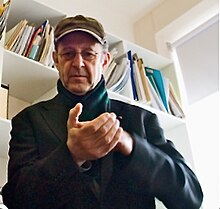Clapping music
Clapping Music is a composition by Steve Reich from 1972. It is a three to five minute long composition for two players and consists of pure hand clapping .
history
Reich and his ensemble toured Europe in 1972. After a concert in Brussels , the organizer asked them if they would like to see a performance of flamenco music . They were visiting a club and watching two musicians who, according to Reich, were terrible guitarists and singers. When the two musicians clapped very loudly, Reich and his group, who were mostly drummers, joined in the clapping. After the concert, Reich realized that he could use this as a basis for his work, not least because a composition consisting only of clapping his hands could be performed with only a few people.
technology
After Reich had already dealt with the mechanics of phase shifting in his early work and the composition Piano Phase had already been published in 1967, his visit to the club encouraged him, as he himself said, "to write music without instruments and only with to be performed on the human body. "
He quickly found, however, that the mechanism of slowly turning the tempo on and off was inadequate for simple clapping in creating the actual sounds that made the music.
Reich found another way: instead of phasing, a player claps a basic rhythm (pattern consisting of twelve beats) in 12/8 time, a variation of the basic African bell pattern, for the entire piece. The other claps the same pattern, but shifts an eighth note to the right after every 8 or 12 bars. The two players continue this until the second player has shifted by 12 eighth notes and therefore plays the pattern (as at the beginning), now about 144 bars later, in sync with the first player. The variation in the African bell pattern is minimal; it only contains one extra punch. However, this minimal addition results in a much more interesting effect in terms of variation to create different rhythmic canons . For the listener, the clappers move away and then return to synchronous or unison.
occupation
The cast is: "For two pairs of clapping hands."
reception
Clapping Hands has been performed by numerous well-known performers.
Despite the simple basic pattern, it is quite demanding for the second player who has to "break out of the rhythm".
Scientists from Queen Mary University in London developed a player-based app in 2015. The app takes on the role of the cast member who plays the static pattern and the user takes on the role of cast member who makes the pattern transitions. Users from more than 100 countries have downloaded the app more than 250,000 times since it was launched in July 2015. There were three levels of difficulty in the app - easy, medium and difficult: 19 percent of the players (21,603 players) completed a full performance of the piece without making a mistake. With games completed, the average accuracy was 91 percent on the hard level, 84 percent on the medium level, and 78 percent on the easy level. The data of the players in the app are evaluated by the scientists and should provide insights into aspects of music psychology, rhythm accuracy and psychology.
One of the findings of the scientists from London was that the accuracy of the performance does not depend on the complexity of the individual rhythms in the piece, but on the complexity of the transition between the rhythms.
Commentary by the composer
When asked whether Reich would change anything in the composition today, he replied:
"Nothing! It's perfect! Not every piece I write is perfect, but this one, it's perfect. "
Premiere
The piece premiered in the summer of 1972.
Web links with audio examples
- Rich, Steve. "Steve Reich Clapping Music Video Medium" . stevereich.com
- Clapping Music (1972) (Steve Reich and Kristjan Järvi), Salle Pleyel, Paris, 2014
Individual evidence
- ^ How I Wrote ... Clapping Music - Steve Reich. Retrieved December 29, 2019 .
- ^ Reich: Clapping Music for 2 players. In: www.universaledition.com. Universal Edition, accessed December 29, 2019 .
- ↑ Justin Colannino, Francisco Gomez, and Godfried T. Toussaint, "Analysis of emergent beat-class sets in Steve Reich's Clapping Music and the Yoruba bell timeline," Perspectives of New Music April of 2009.
- ^ Steve Reich - Clapping Music. Retrieved December 29, 2019 .
- ↑ a b Sam Duffy: Clapping Music app reveals that changing rhythm isn't so easy. In: https://www.sciencedaily.com/ . Queen Mary University of London, October 19, 2018, accessed December 29, 2019 .
- ^ How I Wrote ... Clapping Music - Steve Reich. In: www.classicfm.com. Classic FM, accessed December 29, 2019 .


